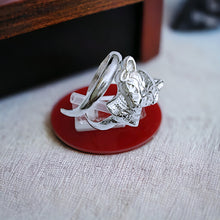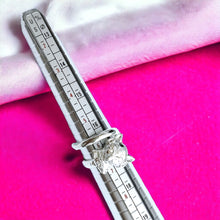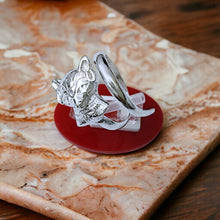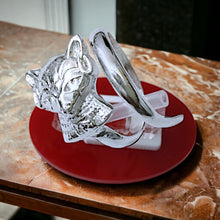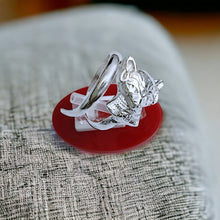
The Silver Goddess Bastet The Cat Adjustable Ring is a piece of jewelry inspired by the ancient Egyptian goddess Bastet, known for her association with home, fertility, and women's secrets. Crafted from sterling silver, this ring features a design reminiscent of Bastet, who was often depicted as a lioness or a woman with a lioness head. The adjustable nature of the ring ensures a perfect fit, making it both a stylish and functional tribute to ancient Egyptian culture and mythology.
- History: Inspired by ancient Egyptian culture, particularly the worship of Bastet, the feline goddess.
- Spiritually: Represents protection, fertility, and feminine power, drawing from Bastet's attributes.
- Talisman: Considered a lucky charm, believed to bring blessings and ward off negativity.
- Handmade: Crafted with care and attention to detail, ensuring uniqueness and quality.
- Healing: Some believe it carries healing energies, promoting emotional balance and well-being.
- Material: Made from sterling silver, renowned for its purity and durability.
- Symbolism: Depicts the sacred feline form of Bastet, embodying grace, intuition, and independence.
- How to Wear: Adjustable ring design allows for comfortable and versatile wearing, fitting various finger sizes with ease.
History Side For Those Who Are Interested
Bastet, the Egyptian goddess of home, fertility, and domesticity, holds a significant place in the pantheon of ancient Egyptian deities. Her origins trace back to the earliest periods of Egyptian civilization, with her cult center primarily located in the city of Bubastis (modern-day Tell Basta) in the Nile Delta region.
In ancient Egyptian mythology, Bastet was depicted as a lioness-headed goddess, representing both ferocity and nurturing qualities. However, over time, her image transitioned to that of a domestic cat, reflecting her associations with domesticity and fertility. She became closely linked with the protection of households, women, and children, as well as with the pleasures of life.
The worship of Bastet flourished during the New Kingdom period (c. 1550–1070 BCE), reaching its peak in popularity. She became one of the most beloved and widely worshipped deities in ancient Egypt, with temples dedicated to her found throughout the country.
The annual festival of Bastet, known as the Festival of Bubastis, was celebrated with great fervor and attracted devotees from all over Egypt. The festival, held in honor of the goddess, included music, dance, feasting, and other joyful festivities. Pilgrims traveled to Bubastis to participate in the celebrations and to make offerings to the goddess, hoping for her protection and blessings.
Bastet was also revered as a guardian deity, particularly in her role as a protector against evil spirits and disease. Cats, which were regarded as sacred animals associated with Bastet, were highly esteemed in ancient Egyptian society and often kept as pets in households. Killing a cat, even accidentally, was considered a serious offense punishable by law.
During the Late Period of ancient Egyptian history (c. 664–332 BCE), the cult of Bastet underwent a resurgence, with renewed interest in her worship and the construction of elaborate temples dedicated to her. However, with the decline of ancient Egyptian civilization and the rise of Christianity in Egypt, the worship of Bastet gradually waned, and her temples fell into ruin.
Today, Bastet remains an iconic figure in Egyptian mythology, symbolizing the harmony between the fierce and nurturing aspects of femininity, as well as the bond between humans and animals. Her imagery and influence continue to captivate the imagination of people around the world, reflecting the enduring legacy of ancient Egyptian culture and spirituality.







